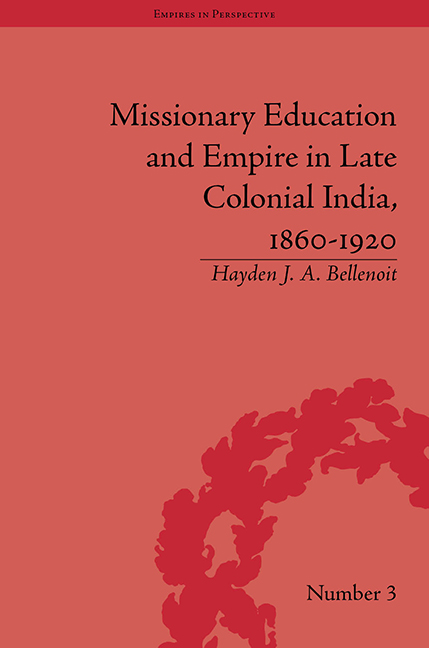Book contents
- Frontmatter
- CONTENTS
- List of Tables
- Acknowledgments
- Glossary
- List of Abbreviations
- Introduction
- 1 Knowledge, Religion and Education in Early Modern India
- 2 British Fears and Indian Society in the Emergence of North Indian Education, c. 1860–1920
- 3 Between East and West: Orientalism, Representations of and Engagements with India
- 4 The Failures of Education and its Sociological Bearings
- 5 Religious Interaction, the Curriculum and Indian Contestations of Late Colonial Knowledge
- 6 Maintaining Missionary Influence: Nationalism, Politics and the Raj c. 1870–1920
- Conclusion
- Notes
- Works Cited
- Index
Introduction
- Frontmatter
- CONTENTS
- List of Tables
- Acknowledgments
- Glossary
- List of Abbreviations
- Introduction
- 1 Knowledge, Religion and Education in Early Modern India
- 2 British Fears and Indian Society in the Emergence of North Indian Education, c. 1860–1920
- 3 Between East and West: Orientalism, Representations of and Engagements with India
- 4 The Failures of Education and its Sociological Bearings
- 5 Religious Interaction, the Curriculum and Indian Contestations of Late Colonial Knowledge
- 6 Maintaining Missionary Influence: Nationalism, Politics and the Raj c. 1870–1920
- Conclusion
- Notes
- Works Cited
- Index
Summary
The main purpose of this book is to explore the development and impact of English and ‘modern’ forms of education upon Indian society. It is intended, primarily, as a contribution to South Asian history. Yet in doing so it will also contribute to the imperial, social and religious histories of the subcontinent. It seeks to explore the larger field of education in north India from the mid-nineteenth century to the outbreak of all-India nationalist mobilization led by Gandhi and Congress in the early 1920s. In particular, it relates pedagogy ‘on the spot’ with its social contexts and shapers, and with larger intellectual debates, religion, spirituality and Indian patriotism. It casts a wider net than existing historiography to give us a holistic understanding of not only the educational experience but also of colonial interactions, knowledge contestation and the emergence of Indian patriotism. In doing so, it seeks to make a solid and penetrating contribution towards our historical literature.
Education was, politically and imperially-speaking, crucial for the British during the generation of Macaulay and after to fill the lower tiers of a rapidly spawning-out colonial bureaucracy. Most of these clerk jobs were either undesired by the British or could only have been filled by Indians which bilingual abilities. In part, this was needed to serve the needs of the East India Company, which by the 1850s had moved significantly towards statistical compendiums, voluminous cartographic surveys and ethnographic studies as a way of knowing their subjects. Expatriate Company officials and, later on, British administrators serving the Sovereign, relied heavily upon the abilities of both the ‘new public man’ and subordinate English-literate clerks to communicate between increasingly removed British officialdom and the networks of social, aesthetic and affectionate communities in the north Indian hinterland. The colonial bureaucracy would likely have had limited writ without the likes of Shiva Prasad and numerous other English-educated Indians who worked upcountry in the Gangetic hinterland, and across much of India for that matter.
- Type
- Chapter
- Information
- Publisher: Pickering & ChattoFirst published in: 2014



